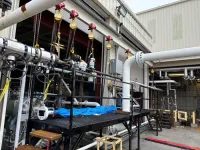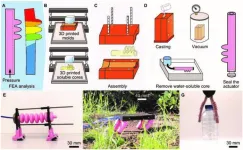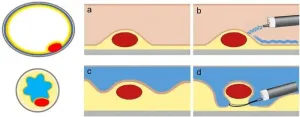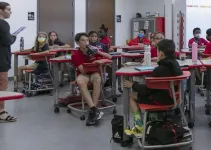(Press-News.org) SAN ANTONIO — September 4, 2024 — Southwest Research Institute has signed a memorandum of understanding (MOU) with Blade Energy Partners, establishing a new research collaboration focused on advancing carbon dioxide storage technology to reduce greenhouse gas emissions.
Carbon capture, utilization, and storage (CCUS) refers to the practices of capturing CO2 from its industrial sources or the atmosphere, transport it using pipelines and other means, using it as alternative fuel or other industrial applications, and storing it for later use. The drive to meet net-zero greenhouse gas emissions goals and make industrial processes more sustainable has fueled considerable growth in the CCUS market in recent years.
Under the terms of the MOU, SwRI and Blade Energy Partners will address many of the larger-scale problems the energy industry is facing as the CCUS market expands, with a strong focus on sequestration.
“We are not just addressing a single problem, but a combination of challenges to make carbon capture, utilization, and sequestration more accessible to the energy industry at large,” said SwRI’s Dr. Florent Bocher, who leads the project.
The organizations will explore the challenges industry professionals may face when storing CO2 in its supercritical state. Supercritical CO2 (sCO2) behaves like a gas, while having densities similar to a liquid. Its higher density can increase storage capacity by a factor of 10. When used as a thermal medium in power cycles, it can increase efficiency by as much as 10% due to its favorable thermodynamic properties. It is also nontoxic and nonflammable. The Institute is a leader in sCO2 research, especially in the field of rotating machinery, which includes the development of the $169 million, 10-megawatt Supercritical Transformational Electric Power (STEP) Demo pilot plant at the SwRI campus in San Antonio.
“In an effort to accelerate and reduce the cost of large-scale implementation of CCUS, the industry is exploring using existing unused wells to store sCO2,” Bocher said. “But before we proceed, questions need to be answered to ensure the CO2 will not leak and that the integrity of the wells will be maintained. For example, we must know how CO2 will interact with the reservoir rock.”
The MOU will combine experimental and modeling expertise to support research to overcome challenges in the way to safely store CO2 such as degradation of building materials (cements, metallics, or non-metallics), reliability of rotating machinery such as compressors, properties of CO2 contaminated with impurities from upstream processes, interaction and contamination of the CO2 with the surrounding geological environment, and geomechanical analysis.
“We are supporting CCUS solutions that can be implemented very quickly, reduce CO2 emissions in the atmosphere, and provide a transitional option as low-to-no CO2 emissions technologies are being developed,” Bocher said. “Sources of CO2 emissions cannot disappear instantly, but this should not stop us from bridging the gap with realistic solutions for a more sustainable future.”
For more information, contact Florent Bocher.
END
SwRI signs MOU with Blade Energy Partners to support carbon dioxide sequestration research
Research will expand carbon dioxide transport and storage solutions
2024-09-04
ELSE PRESS RELEASES FROM THIS DATE:
Integrated design and fabrication of pneumatic soft robot actuators in a single casting step
2024-09-04
A research paper by scientists at University of Coimbra proposed an integrated approach targeting the design and fabrication of pneumatic soft actuators in a single casting step. Molds and sacrificial water-soluble hollow cores are printed using fused filament fabrication.
The new research paper, published on Jul. 17 in the journal Cyborg and Bionic Systems, presented an integrated process for the design and fabrication of soft robot actuators in a single casting. The author proved the availability, versatility, and effectiveness of the proposed methods, contributing to accelerating the design and fabrication of soft robots.
Bio-inspired soft robots have already shown the ability to handle ...
Underwater resection of neuroendocrine tumors of the gastrointestinal tract
2024-09-04
Neuroendocrine tumors (NETs) of the gastrointestinal (GI) tract are a rare and heterogeneous group of malignancies arising from the neuroendocrine cell system. These tumors are more commonly encountered in the stomach, appendix, small bowel, rectum, and pancreas. Over the past few decades, the incidence of GI NETs has increased due to improved diagnostic capabilities and an aging population. The management of these tumors requires a careful assessment of various factors, including the site, size, grading, depth of invasion, and local lymphadenopathy, as they significantly impact prognosis and treatment ...
Microglial responses to hypernatremia: new insights into brain health
2024-09-04
Microglia are the brain’s immune cells known to play a vital role in maintaining neural function and responding to potential threats. However, when the brain is subjected to hyperosmotic stress—a condition characterized by elevated extracellular sodium levels, the microglial response can become exaggerated, leading to potentially harmful effects. Understanding the mechanisms behind this heightened response is crucial for the treatment of hypernatremia-induced neurological dysfunctions.
To ...
Breaking the link between obesity and atrial fibrillation with a new cellular target
2024-09-04
A cellular link between obesity and atrial fibrillation — a heart condition that afflicts over 33 million people worldwide — presents a promising target for new therapies, researchers from the University of Illinois Chicago report.
Obesity is among the leading causes of atrial fibrillation, an irregular heart rhythm that can lead to heart failure and stroke. But scientists still don’t know how high levels of body fat cause this heart condition.
In a new study published in The Journal of Clinical Investigation, UIC researchers identified a cellular pathway essential to obesity-induced ...
New research has potential to speed up forensic analysis in sexual assault cases
2024-09-04
A team of researchers has developed a radical new technique for analyzing evidence in sexual assault cases. The new approach could streamline the forensics pipeline and reduce delays in the processing of DNA evidence.
The research is described in a paper published today in the journal Advanced Science.
There are almost half a million sexual assaults in Canada every year with many more going unreported. The new approach could mitigate one of the reasons victims are reluctant to report assaults: the perception that ...
Banning friendships can backfire: moms who ‘meddle’ make bad behavior worse
2024-09-04
Delinquent activities almost always occur outside of the home and away from adult supervision, so it is only natural for parents to blame peers for their child’s bad behavior. Not surprisingly, many parents also assume that they can prevent future problems by limiting contact with suspicious peers.
However, a new study cautions parents – especially meddling moms – to resist the temptation to prohibit friendships because doing so only makes a bad situation worse. How can this be?
Results from a new longitudinal study of middle school youth, published in The Journal of Child Psychology and Psychiatry, indicates that maternal disapproval of friends in ...
AIM-HI Accelerator Fund announces the 2024 Women’s Venture Competition winners
2024-09-04
ROCKVILLE, MD (September 4, 2024) The AIM-HI Accelerator Fund is pleased to announce that the 2024 Women’s Venture Competition’s first prize winner with distinction goes to HDAX Therapeutics led by its CEO and Co-Founder, Nabanita Nawar, Ph.D, and the Second Prize Winner goes to ARMA BIO, led by Co-Founder & CSO, Paraskevi Giannakakou, Ph.D.
The 2024 AIM-HI Women’s Venture Competition Committee reviewed more than 50 applications from 10 countries, including Canada, Ghana, India, Israel, Norway, Romania, Singapore, Spain, Thailand, ...
Scientists use magnetic nanotech to safely rewarm frozen tissues for transplant
2024-09-04
Every day, people die waiting for an organ transplant. Time is at a premium, not just for those awaiting organs, but also for the organs themselves, which can deteriorate rapidly during transportation. Looking to extend the viability of human tissues, researchers report in ACS’ Nano Letters their efforts to facilitate completely freezing, rather than cooling and then thawing, potentially life-saving organs. They demonstrate a magnetic nanoparticle’s successful rewarming of animal tissues.
As of August 2024, more than 114,000 people are on the U.S. national transplant ...
Why dinosaur collagen might have staying power
2024-09-04
Dinosaurs continue to fascinate people, but that’s not their only enduring quality: Collagen in their skeletons remains intact for millions of years, despite containing chemical bonds that should only persist for about 500 years. Now, scientists report in ACS Central Science that the unique tenacity of this protein may result from a molecular structure that shields these vulnerable bonds from attack by water that’s present in the environment.
Collagen is the most abundant protein in animals. It’s found in skin and connective tissues, such as cartilage and bones. Fragments of collagen have been ...
Levels of one ‘forever chemical’ are increasing in groundwater, study finds
2024-09-04
Rain and water in ponds and lakes slowly seeps into the soil, moving through minute cracks to refill underground aquifers. Per- and polyfluoroalkyl substances (PFAS), often described as forever chemicals, can tag along into groundwater that’s later removed for drinking. Researchers in ACS’ Environmental Science & Technology Letters analyzed water from over 100 wells in Denmark for one particularly persistent PFAS: trifluoroacetate. They report steadily increasing levels of the forever chemical in recent decades.
Trifluoroacetate forms when fluorinated gases, such as refrigerants, and fluorinated pesticides partially degrade in the environment. Water passing ...
LAST 30 PRESS RELEASES:
Securing AI systems against growing cybersecurity threats
Longest observation of an active solar region
Why nail-biting, procrastination and other self-sabotaging behaviors are rooted in survival instincts
Regional variations in mechanical properties of porcine leptomeninges
Artificial empathy in therapy and healthcare: advancements in interpersonal interaction technologies
Why some brains switch gears more efficiently than others
UVA’s Jundong Li wins ICDM’S 2025 Tao Li Award for data mining, machine learning
UVA’s low-power, high-performance computer power player Mircea Stan earns National Academy of Inventors fellowship
Not playing by the rules: USU researcher explores filamentous algae dynamics in rivers
Do our body clocks influence our risk of dementia?
Anthropologists offer new evidence of bipedalism in long-debated fossil discovery
Safer receipt paper from wood
Dosage-sensitive genes suggest no whole-genome duplications in ancestral angiosperm
First ancient human herpesvirus genomes document their deep history with humans
Why Some Bacteria Survive Antibiotics and How to Stop Them - New study reveals that bacteria can survive antibiotic treatment through two fundamentally different “shutdown modes”
UCLA study links scar healing to dangerous placenta condition
CHANGE-seq-BE finds off-target changes in the genome from base editors
The Journal of Nuclear Medicine Ahead-of-Print Tip Sheet: January 2, 2026
Delayed or absent first dose of measles, mumps, and rubella vaccination
Trends in US preterm birth rates by household income and race and ethnicity
Study identifies potential biomarker linked to progression and brain inflammation in multiple sclerosis
Many mothers in Norway do not show up for postnatal check-ups
Researchers want to find out why quick clay is so unstable
Superradiant spins show teamwork at the quantum scale
Cleveland Clinic Research links tumor bacteria to immunotherapy resistance in head and neck cancer
First Editorial of 2026: Resisting AI slop
Joint ground- and space-based observations reveal Saturn-mass rogue planet
Inheritable genetic variant offers protection against blood cancer risk and progression
Pigs settled Pacific islands alongside early human voyagers
A Coral reef’s daily pulse reshapes microbes in surrounding waters
[Press-News.org] SwRI signs MOU with Blade Energy Partners to support carbon dioxide sequestration researchResearch will expand carbon dioxide transport and storage solutions





